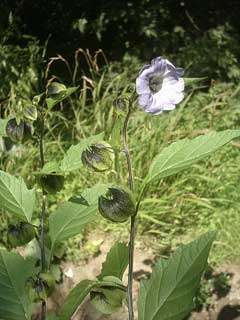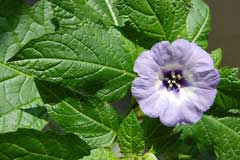 |
|
http://commons.wikimedia.org/wiki/User:Aragorn05 |
 |
| http://commons.wikimedia.org/wiki/User:Boronian |
Translate this page:
Summary
Physical Characteristics

 Nicandra physaloides is a ANNUAL growing to 1.2 m (4ft) at a fast rate.
Nicandra physaloides is a ANNUAL growing to 1.2 m (4ft) at a fast rate.
See above for USDA hardiness. It is hardy to UK zone 8. It is in flower from July to September. The species is hermaphrodite (has both male and female organs).
Suitable for: light (sandy), medium (loamy) and heavy (clay) soils and prefers well-drained soil. Suitable pH: mildly acid, neutral and basic (mildly alkaline) soils. It cannot grow in the shade. It prefers moist soil.
UK Hardiness Map
US Hardiness Map
Synonyms
Plant Habitats
Cultivated Beds;
Edible Uses
Edible Parts: Fruit Leaves
Edible Uses:
Fruit[177]. No more details are given. The fruit is a berry about 15mm in diameter[200]. Young leaves - boiled[177]. Some caution is advised, see the notes above on toxicity.
References More on Edible Uses
Medicinal Uses
Plants For A Future can not take any responsibility for any adverse effects from the use of plants. Always seek advice from a professional before using a plant medicinally.
Analgesic Anthelmintic Antibacterial Antiinflammatory Diuretic Febrifuge Mydriatic
The plant is diuretic[240]. There is no evidence to suggest that the plant is purgative, though an alkaloid with mydriatic action is present[240]. The seeds are used in Tibetan medicine, they are said to have an acrid taste and a cooling, very poisonous potency[241]. Analgesic, anthelmintic, antibacterial, anti-inflammatory and febrifuge, regular use increases bodily vigour[241]. They are used in the treatment of contagious disorders, toothache, intestinal pain from worms and impotence[241]. A decoction of the seeds is used in the treatment of fevers[272].
References More on Medicinal Uses
The Bookshop: Edible Plant Books
Our Latest books on Perennial Plants For Food Forests and Permaculture Gardens in paperback or digital formats.

Edible Tropical Plants
Food Forest Plants for Hotter Conditions: 250+ Plants For Tropical Food Forests & Permaculture Gardens.
More

Edible Temperate Plants
Plants for Your Food Forest: 500 Plants for Temperate Food Forests & Permaculture Gardens.
More

More Books
PFAF have eight books available in paperback and digital formats. Browse the shop for more information.
Shop Now
Other Uses
Repellent
The plant is thought to repel flies[188].
Special Uses
References More on Other Uses
Cultivation details
Succeeds in ordinary garden soil[1], but prefers a rich well-drained soil in a sunny position[200]. Plants withstand poor weather conditions well and do not usually require staking[200]. Plants are fast-growing[188] and often self-sow freely[200]. Individual flowers only live for one day, but the plant produces a succession of flowers from summer to early autumn[188].
References Carbon Farming Information and Carbon Sequestration Information
Temperature Converter
Type a value in the Celsius field to convert the value to Fahrenheit:
Fahrenheit:
The PFAF Bookshop
Plants For A Future have a number of books available in paperback and digital form. Book titles include Edible Plants, Edible Perennials, Edible Trees,Edible Shrubs, Woodland Gardening, and Temperate Food Forest Plants. Our new book is Food Forest Plants For Hotter Conditions (Tropical and Sub-Tropical).
Shop Now
Plant Propagation
Seed - sow in situ in late spring, preferably after the last expected frosts[200]. Young seedlings can be transplanted. The seed can remain dormant for several decades[200].
Other Names
If available other names are mentioned here
Native Range
Coming Soon
Weed Potential
Right plant wrong place. We are currently updating this section.
Please note that a plant may be invasive in one area but may not in your area so it's worth checking.
Conservation Status
IUCN Red List of Threatened Plants Status :

Growth: S = slow M = medium F = fast. Soil: L = light (sandy) M = medium H = heavy (clay). pH: A = acid N = neutral B = basic (alkaline). Shade: F = full shade S = semi-shade N = no shade. Moisture: D = dry M = Moist We = wet Wa = water.
Now available:
Food Forest Plants for Mediterranean Conditions
350+ Perennial Plants For Mediterranean and Drier Food Forests and Permaculture Gardens.
[Paperback and eBook]
This is the third in Plants For A Future's series of plant guides for food forests tailored to
specific climate zones. Following volumes on temperate and tropical ecosystems, this book focuses
on species suited to Mediterranean conditions—regions with hot, dry summers and cool, wet winters,
often facing the added challenge of climate change.
Read More
Expert comment
Author
(L.)Gaertn.
Botanical References
200
Links / References
For a list of references used on this page please go here
Readers comment